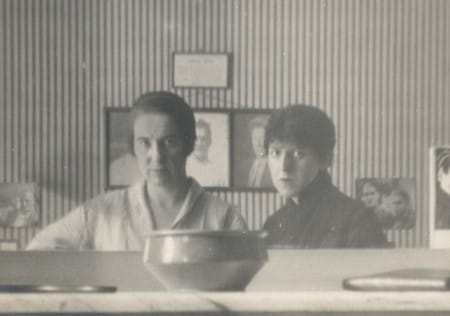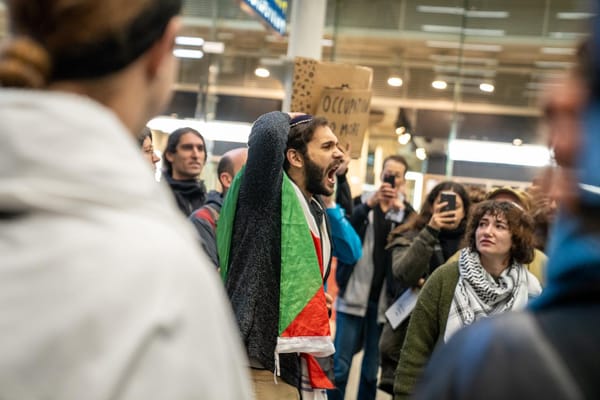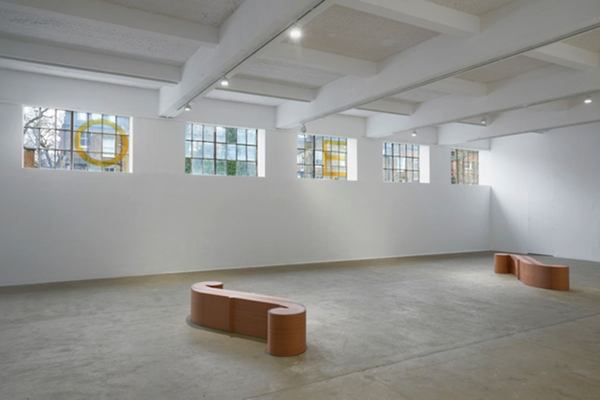The queer surrealist lovers who took on the Nazis
Remembering the queer, anti-Nazi art of Claude Cahun and Marcel Moore.

In Nazi-occupied Jersey, Claude Cahun and Marcel Moore led an unlikely resistance campaign, one recounted by Livvy Drusilla and Anna George in their new zine, Another Mask.
In June of last year, we embarked on a pilgrimage to Jersey. We weren’t there for the beaches, nor for the tax haven. No, we had come to the island, the largest in the Channel, in search of a pair of queer lovers, Nazi resisters and cat-obsessed surrealists.
Claude Cahun and Marcel Moore moved to Jersey in 1937, likely in a bid to escape growing antisemitism in their native France (Cahun was Jewish, Moore was not). But with cruel irony, Jersey fell to the Nazis three years later, and Cahun and Moore’s house was partly requisitioned by the German army. The pair had strong political convictions, having been involved with Parisian communist and antifascist groups, including Contre-Attaque and the Association of Revolutionary Writers and Artists. Their fervent opposition to both the war and Nazism spurred the pair into action.
Cahun and Moore undertook an intrepid resistance campaign under the noses of the soldiers billeted in their house. The duo were extraordinarily prolific, working with obsessive frenzy to produce satirical surrealist collages and cartoons with witty wordplay. In July of 1944 however, Cahun and Moore were arrested and charged with inciting German troops to rebellion. Over the course of almost four years, the duo had produced thousands of pieces of handmade antifascist propaganda. At trial, they were found guilty and sentenced to death and six months’ imprisonment. Upon receiving the verdict, Cahun is said to have asked which of the two sentences they were expected to serve first.
As it turned out, Jersey was liberated in May 1945, and the sentences were overturned. The pair were released and continued to live on the island together until their deaths in 1954 and 1972 respectively. While Cahun died at 60 from poor health, exacerbated by their incarceration, Moore took her own life aged 79. They are buried together in the church beside their house in St Brelade’s Bay, a site we visited on our trip to the island. Their lives and work have not received due recognition on the island, despite growing international interest in their work since the 1980s.

Cahun first met Moore in what they subsequently described as ‘une recontre foudroyante’ (‘a lightning encounter’), a sentiment that also encapsulates the way we, the authors, felt upon first learning about the duo’s shared life and work. We recognised aspects of ourselves in Cahun and Moore; aspects that seemed to be underplayed and (wilfully?) misconstrued in articles and exhibitions of their work. The zine, therefore, was born out of our shared love for, and identification with, the pair as a gender/queer duo, as well as our frustration with the ways they have been – and continue to be – misrepresented. We adopted their collaborative practice and embarked on a zine-writing project of self-discovery, one that would challenge art histories that label their art as “deviant” or “degenerate” and resist the tendency to categorise radical queerness out of existence.
Here, we share two edited extracts from the publication which focus on Cahun and Moore’s resistance activity and the radical potential of Surrealist practice.
In the archive
The political leaflets and tracts produced by Cahun and Moore while the island was under Nazi occupation are striking in their fragility. Moore learnt German as a child, which the two put to use, making antifascist propaganda, which they signed ‘Der Soldat ohne Namen’ (‘The Soldier Without a Name’). These typed or handwritten flyers – sometimes printed on rationed toilet paper – contained anti-Nazi slogans and satirical sketches which the duo left on German car windscreens, or hid in cigarette packets and between the pages of newspapers, and even in soldiers’ pockets when they dared. The vast majority have not survived.
As we leaf through the archives, we wonder if the fragility of these documents speaks to the desperateness of their situation under occupation and war rationing. Or whether it was instead a concerted effort to use commonly available resources, so as to be less discernible to the authorities, less traceable? We know they employed different tones, styles of handwriting, even different languages – German, Polish, French, English – to create the illusion of a coordinated, collective resistance, the kind they desperately sought to inspire on the island and never really found, at least not to the degree to which they had hoped.

The illusion worked: when Cahun and Moore were put on trial by a Nazi court in 1944, the authorities refused to acknowledge that two people alone could have done so much. There must have been more of them, a whole army of co-conspirators. With over 350 distributed objects and tracts used as evidence – a fraction of what they produced – their trial became, in the words of their biographer François Leperlier, “an accidental installation of their life and work”. It’s also likely that their collective efforts overwhelmed the authorities all the more because of the couple’s perceived gendered/class positions. Lepelier continues:
Surrealism as political resistance
Surrealism asks us to look askew at the world, to question received wisdom and put seemingly contradictory or unrelated elements into conversation, birthing fresh insight and scenarios calling into consideration the strange everyday. As an artistic movement, it was also one sadly dominated by homophobia and misogyny. André Breton, a key player in the surrealist movement and author of one of many surrealist manifestos, was outwardly disparaging of Cahun’s “unconventional” dress, behaviour and sexuality. It is unfortunately no surprise, therefore, that even in this “revolutionary” artistic movement, the works of women, queer people and people of colour were sidelined. Cahun and Moore never really enjoyed success or artistic recognition in their lives, within or outside the surrealist movement, partly for this reason. Other figures, such as René Crevel and Leonor Fini, have likewise been relegated to the margins.

Indeed, it seems there is a bind between the radical freedom a movement like surrealism might enable, and the conservative reality which dominated it, particularly under figures such as Breton. Nonetheless, for those who sat at its edges, the artistic potential of surrealism seemed to offer a space in which one can exist outside the norms of the time. In Cahun and Moore’s case, it provided a space in which their genders, their nonconformist way of living and loving could exist decades before these ideas were theorised and formally recognised.
Now that the value of their artistic work is increasingly being understood, we suggest that their resistance work also merits consideration as an artistic practice. When conceptualised as surrealist work, their antifascist leaflets, collages and sabotage are given even greater depth. Think of the artistic ingenuity involved in uncoiling cigarette packets in order to draw anti-Nazi cartoons inside before painstakingly glueing these same cigarette packets back together and slipping them repurposed into the pockets of soldiers’ coats. Or buying a magazine then reworking the entire contents into elaborate photo collages, each page a rallying cry against fascism, before returning these clandestinely to the shelves of local newsagents. It is art living politically: inspiring, radical and brilliant. ▼
Another Mask is available on Etsy.




